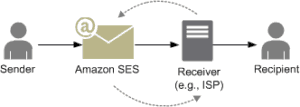SES Bounce Rate – How to reduce Amazon SES bounces in an easy and effective way?
You’ll learn what are email bounce backs, how to calculate your bounce rate, how to turn on your bounces notifications but more importantly how to keep your bounce rate low with email verification API.

Solving your Amazon SES bounce rate issue
We’ve written this article to help Amazon SES users to find a simple solution to a high bounce rate. A variety of email sending services use integration with Amazon SES in order to reduce the costs of email marketing, hence if you use such, this article might also concern you.
Amazon SES – affordable but focused on email deliverability
Amazon Simple Email Service (Amazon SES) is a cloud-based email sending service designed to help digital marketers and application developers send marketing, notification, and transactional emails. It is a service for businesses of all sizes that use email as a way of contact with their customers. It not only very cost-effective but also very reliable. Users tend to use Amazon SES for sending a high number of emails. They act very carefully regarding their reputation, and they take strict measures to stop spammers. That is why they watch closely their users’ bounce and complaint rates. Therefore it is crucial that users understand what bounces are, and how a high bounce rate can influence their sender’s reputation.
What is a bounced email?
When an email message cannot be delivered to an email address, it’s called a bounce. There is a variety of reasons as to why your email bounced, but when it happens, a “return to sender’ message with an explanation is sent to your mailbox.
There are two types of bounces, soft and hard:
Soft bounces are a temporary delivery failure. They can occur when the recipient’s inbox is overload, out of function, the message size is too large, spammy content has been detected. It can also happen due to server issues and many more. However, the soft bounce does not automatically indicate that the email address is inactive or invalid.

Hard bounces are a permanent delivery failure. In most cases, caused by recipient email address or domain name that does not exist, a recipient email server that has completely blocked delivery, or mistyping of the address (for example gmil.com instead of gmail.com)

What is a bounce rate?
Bounce rate is the rate of rejected messages in reference to all the sent messages. If 10 emails out of 100 will bounce the bounce rate will be 10%. High bounce rate can indicate to ISPs that the sender’s email sending practices are of low quality, therefore the emails from the sender should be sent to the spam folder or blocked. Being marked as a spammer, influence the reputation of the sender negatively. Sender reputation is an indication of the trustworthiness of an email sender’s IP address and sending domain. Maintaining a positive sender reputation is crucial to the success of your email program.
Of course, having a 0% bounce rate is desirable, but it’s almost impossible to obtain. A healthy opt-in list should be seeing bounce rates of between 2-3%. If you are regularly generating higher bounce rates, it’s important that you work out why and take action to reduce the number of bounces.
How to turn on Bounce Notifications in Amazon SES?
In order to send email using Amazon SES, you must have a system in place for managing bounces and complaints. You can set up the Bounce notifications by following the detailed instructions here: https://docs.aws.amazon.com/ses/latest/DeveloperGuide/monitor-sending-activity-using-notifications.html
Amazon SES Bounce Rate issue explained
Amazon SES has an attractive offer for those that use bulk messaging, not only due to their competitive pay-per-use pricing but also due to the fact that ISPs trust that messages coming from SES are from a proven source. To ensure that questionable content is not being sent via their service, Amazon actively monitors hard bounces and complaints. Amazon SES recommends that senders maintain bounce rates below 5%. They do place the account that exceeds a 10% bounce rate on probation or even get the account suspended. You might reduce your bounce rate by removing undeliverable emails from your list with email checker like Bouncer.
How to keep your bounce rate low with Email Verification API?
If you are exceeding the 5% bounce rate threshold (or getting close to it), while sending your emails via Amazon SES, you’ll need to take actions ASAP. Delete subscribers whose email is no longer valid to avoid bounces. As advised by Amazon SES, it is best to use 3rd party services to verify your list and to segregate the deliverable addresses from undeliverable or risky. The best possible solution for this would be to implement an email verification API within your sending strategy. By doing so, you will be able to verify your recipients in batches prior to the send out of your campaign, so you can remove those that might hurt your bounce rate.
Bouncer Email Verification API
Use a trustworthy service that will keep your data safe, has a great accuracy of the results and superb support. Bouncer is an email checker that not only ticks all those boxes but is also fully GDPR compliant and is faired priced. Implement Bouncer’s Email Verification API and never worry again about the risk of getting suspended!
When verifying any email address, Bouncer uses a variety of processes, that are later analyzed to provide you with a result:
First, SYNTAX – simple check of the syntax of the email address, to see if the address looks valid.
Next, DNS check – verification if a domain exists in DNS.
Later, checking the MX records using DNS.
Last, establishing an SMTP connection with the recipient’s server to verify if the mailbox indeed exists. This is the most complicated part of the email verification process.
Bouncer can return the data in JSON format. Additionally, you might receive information if the email is:
- disposable
- set up as a catch-all, accept-all
- free
- role
There are two ways to integrate with Batch Email Verification API:
- using status endpoint, or
- using a callback parameter.
You will find detailed API references here.
Pro tip: You can also follow the standard email sending tips and practices
In order to meet the ISP’s standards, you should follow the best email sending practices to avoid email spam filters. If you follow the below you will be able to improve your sender reputation, increase your deliverability and lower the bounce rate:
1. Always provide the recipients with an unsubscribe link! If the link is visible and placed on top of the email, people will prefer to press that, instead of ‘mark as spam’ button.
2. It is wise to inform your recipients why did they receive your email. If such information is unavailable, they are more likely to report your email as spam.
3. DO NOT USE purchased, scraped, rented lists! The same list was already bought by plenty of other companies. The possibility of success of your email campaign will be very low, as high-quality emails are not for sale. You should collect the email addresses yourself, directly from recipients.
4. Try to lower the number of images and links that you put in your message. Make sure the links are visible, not broken and that you actually have pages behind your links.
5. Provide value!
Wrapping up
Keeping your bounce rate low can be time very energy and time consuming if you decide to do it manually. However, implementing Bouncer’s Email Verification API, and verifying your lists in batch prior the send out would be the easiest and most effective way to keep your bounce rate low, thus keep your Amazon SES account active.

Keep calm and verify with Bouncer
If you would like to chat about your experience with email deliverability, your issues with bounce rate, about Bouncer and features that would be important for you or anything else, please select a suitable time via our calendar, to set up a 15-30 minute video call.
Further reading:
https://docs.aws.amazon.com/ses/latest/DeveloperGuide/reputationdashboardmessages.html
https://media.amazonwebservices.com/AWS_Amazon_SES_Best_Practices.pdf













